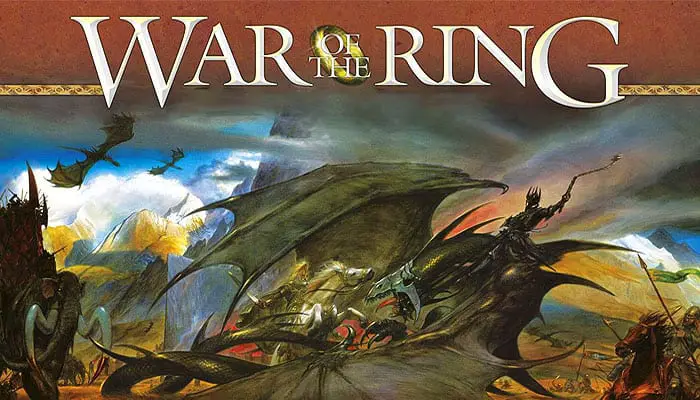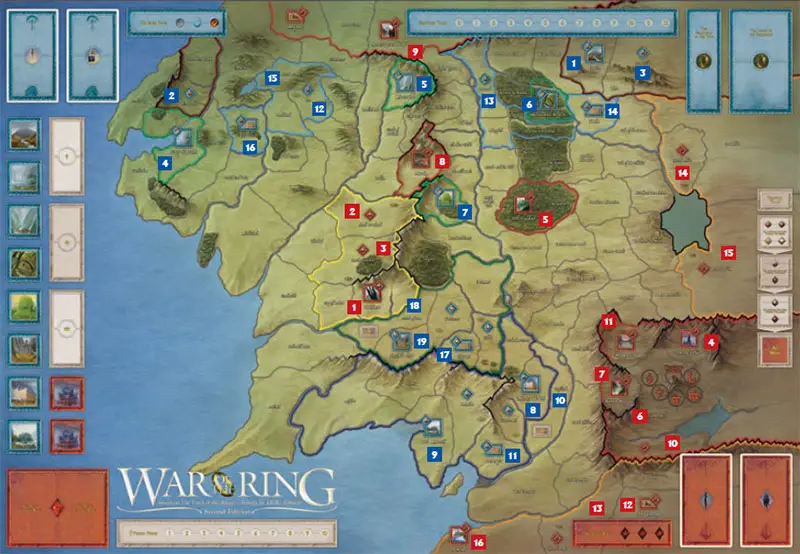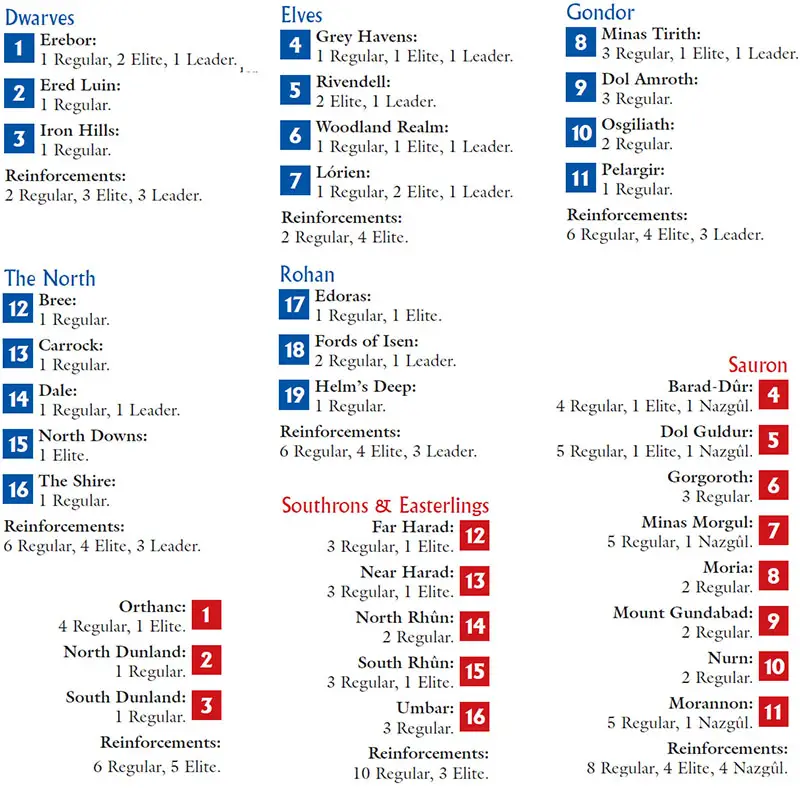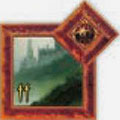
Components

- 1 Game Board, composed of two fold-out sections
- 2 Player Aids
- 6 Free Peoples Action Dice
- 10 Shadow Action Dice
- 5 six-sided Combat Dice
- 10 Companion Cards
- 1 Gollum Card
- 3 Minion Cards (Shadow Characters)
- 96 Event Cards (divided into 4 decks of 24 cards each)
- 205 plastic figures representing the Armies and Characters of the War of the Ring
- 76 cardboard counters and markers, including:
- Rulebook
Setup
Before you start playing, you should decide who will play the Free Peoples and who will play the Shadow.
Then, get the game ready to play by following these steps.
-
Place the game board on a suitable surface, possibly large enough to leave some room along the sides of the board (to place discarded cards and eliminated pieces and to roll dice).
-
Place the Ring-bearers figure on Rivendell, its starting point.
-
Place the Fellowship Progress counter on Step 0 of the Fellowship Track, with the "Hidden" side up. The Corruption counter is also placed on Step 0 of the same track.
-
Place all Companion cards in the Guide of the Fellowship Box, with the Gandalf the Grey Character card on top, as he is the starting Guide of the Fellowship. Set aside the cards for Aragorn - Heir to Isildur, Gandalf the White, and Gollum for later use.
-
Place all the Companion figures and their counters in the The Fellowship of the Ring Box. Set aside the Gollum figure for later use.
-
Place the three Elven Ring counters in the Free Peoples' Elven Rings Box of the game board with the "Ring" side up.
-
Set aside all Shadow Minion cards (the Witch-king, Saruman, and the Mouth of Sauron) and the corresponding figures for later use.
-
Separate the Free Peoples and Shadow Event cards into Character and Strategy decks according to the back of each card, shuffle them separately, and place them on the corresponding areas of the game board.
-
Put the standard Hunt tiles (beige) in a cup or other opaque container: this is the Hunt Pool. Set aside the special Hunt tiles (blue and red) for later use.
-
Give seven red Shadow Action dice to the Shadow player and four blue Free Peoples Action dice to the Free Peoples player. Set aside the remaining Action dice for later use. Set aside the five Combat dice.
-
Place the Political counter for each Free Peoples Nation on its starting point on the Political Track. All of the Free Peoples Nations' Political counters except for that of the Elves are placed with the "Passive" side up.
The Political counters of the Elves and all the Shadow Army Nations are placed with the "Active" side up. As indicated by the symbols on the track, place the Rohan, the North, the Elven, and the Dwarven Nations' Political counters in the top box, place the Gondor and Southron/Easterling Political counters in the second box from the top, and finally place the Sauron and Isengard Political counters in the third box from the top-immediately above the "At War" box.
-
Sort all the plastic figures by their color and their type and follow the Army Setup diagram on pages 16-17 to place each Nation's initial Army units and Leaders. Set aside any remaining figures to use as reinforcements, paying attention not to mix them with pieces eliminated from play as the game progresses. Set aside the Army counters for use later in the game.
Keep all the remaining components in the box; they will be used later in the game.
Army Setup


Game Play
War of the Ring is played over a series of turns, until either player wins the game. Each turn is divided into six phases.
The phases of the turn are:
-
Phase 1: Recover Action Dice And Draw Event Cards
Each player recovers the Action dice he used in the previous turn, plus any dice which were added to the Action Dice Pool and minus any dice which were removed from the pool.
Then, each player draws 2 cards, one from each of their respective Event decks.
-
Phase 2: Fellowship Phase
The Free Peoples player may now declare the position of the Fellowship.
If the Fellowship is declared in a City or Stronghold of a Free Peoples Nation, that Nation is activated (if the Nation is showing "Passive" on the Political Track, flip the Nation to "Active") and the Ring-bearers may be healed.
Also, during this phase, the Free Peoples player may change the Guide of the Fellowship.
-
Phase 3: Hunt Allocation
The Shadow player may now place a number of Action dice in the Hunt Box located on the game board. The Shadow player must place at least one Action die if the Free Peoples player retrieved at least 1 die from the Hunt Box during Phase 1.
He may allocate only as many dice as the number of Companions remaining in the Fellowship. These dice are not rolled during the following Action Roll phase.
-
Phase 4: Action Roll
Players roll their Action dice (except the dice already in the Hunt Box). Then, the Shadow player immediately takes all the rolled dice showing the "Eye" result and adds them to the Hunt Box.
-
Phase 5: Action Resolution
This phase is the primary game phase of the War of the Ring board game.
It is during this phase that players will utilize the Action dice results to move their Characters and Armies on the game board, or to take other important actions.
The results of the rolled Action dice dictate the actions the players can take during this phase. Starting with the Free Peoples player, the two players alternate actions, each taking one action by selecting and removing one of his available die results.
Each time the Free Peoples player uses an Action die to move the Fellowship, he places that die in the Hunt Box after completing the action. All other used dice are set aside until next turn.
The use of each different Action die is described in more detail later.
-
Phase 6: Victory Check
Players now check to see whether either player has achieved the Military Victory conditions. If not, a new game turn begins.
Note: If a Ring-based Victory condition occurs at any time during a turn, the game ends immediately, without waiting for the Victory Check phase.
The Action Dice
The Action dice play a fundamental role in the game, as they dictate the options available to each player during a turn.
These dice have special icons on their faces, each icon representing a different group of action from which the players may choose. The different numbers and types of icons appearing on the Free Peoples Action dice and Shadow Action dice reflect the different attitudes of the two sides fighting the War of the Ring.
The Action Dice Icons table, on the facing page, shows the meaning of these icons.
Note: The Free Peoples Action dice have two faces which show the "Character" action, and that on these dice the "Army" action only appears on a face combined with the "Muster" action.
Action Dice Pool
The total number of Action dice rolled by a player in a turn is called his dice pool.
The Shadow player starts the game with seven dice in his pool, but may gain additional dice later in the game, up to a maximum of ten. These additional Action dice enter play when the Shadow player brings his Minions into the game (one die for Saruman, one for the Witch-king, one for the Mouth of Sauron).
Action Dice Icons

(*) Note: the Free Peoples Action dice have two faces which show the Character action. On these dice, the "Army" action only appears on a face combined with the Muster action.
The Free Peoples player starts with four dice in his pool. Like the Shadow, he can also gain additional dice later in the game. The Free Peoples player adds one die to his dice pool when Aragorn - Heir to Isildur enters play and another one when Gandalf the White appears.
Both the Shadow and the Free Peoples player lose the additional die if the corresponding Character is eliminated.
When a player gains or loses an Action die, the gain or loss becomes effective in the next turn: the die is added to, or removed from, the dice pool during the Recover Action Dice and Draw Event Cards phase of the following turn.
Hunt allocation and action roll
The Shadow player, during the Hunt Allocation phase, places the number of Action dice into the Hunt Box that he wants to devote to the Hunt for the Ring.
If one or more Fellowship Action dice were in the Hunt Box at the end of the previous turn, he must place a minimum of 1 die in the Hunt Box.
The maximum number of dice he can place in the Hunt Box is equal to the number of Companions currently in the Fellowship (note that the Ring-bearers are not considered to be a Companion and do not add to this maximum).
However, the Shadow player may always place at least one die in the Hunt Box, even if all the Companions have left the Fellowship.
The dice placed in the Hunt Box are not rolled, but the Shadow player rolls the remaining dice in his dice pool, and all dice showing an "Eye" result are immediately added to the Hunt Box as well.
The Free Peoples player simply rolls his entire Action dice pool.
Using Action Dice
Starting with the Free Peoples, players alternate actions selecting one of their Action dice and immediately taking the action made available by the specific die result.
Each Action die is printed with a set of distinctive icons, corresponding to different game actions. Each action is detailed later in the rules and summarized in the Action Dice Reference Chart (see page 20; the chart is also included in the Player Aids).
When an action has been completed, the corresponding die is considered "used" and is set aside until needed again for the next turn.
The only exception to this rule is that each time the Free Peoples player uses an Action die to move the Fellowship, he places that die in the Hunt Box after completing the action rather than setting it aside (note that the die is returned to the Free Peoples player during the Recover Action Dice and Draw Event Cards phase of the next turn).
If a player has fewer unused Action dice than his opponent (typically the Free Peoples player will have fewer Action dice than the Shadow player), he can pass instead of taking an action, thus allowing the opponent to take another action.
Action Dice Reference Chart
This section provides a quick summary of the actions that each player can take using Action dice.
Character
This die result can be used to execute one of the following actions:
Leader Moves/Attacks with Armies.
Move an Army with a Leader to an adjacent region, which must be free for the purposes of Army movement; or attack an enemy Army in an adjacent region (or conduct a sege battle or sortie) using an Army with a Leader.
Play an Event card.
Play a Character Event card from your hand.
Free Peoples Only
Fellowship Progress.
Move the Fellowship Progress counter one step forward on the Fellowship Track. Resolve the Hunt for the Ring, and then place the used Action die in the Hunt Box.
Hide the Fellowship
If the Fellowship was previously revealed, it becomes hidden again.
Separate Companions
Separate one Companion or one group of Companions from the Fellowship. The Companion figures are removed from the Fellowship Box and must move on the map, up to a distance from the Fellowship equal to the step number on the Fellowship Track plus the highest Companion Level.
Move Companions.
Move all Companions or groups of Companions on the map, each up to a number of regions equal to that of the highest Companion Level in the group.
Shadow Only
Move Minions
Move all Nazgul (including the Witch-king) anywhere on the map (except into a region that contains a Stronghold controlled by the Free Peoples, unless a Shadow Army is besieging it). Move other Minions according to their Level.
Army
This die result can be used to execute one of the following actions:
Move Armies
Move up to two different Armies from their region(s) to adjacent region(s), which must be free for the purposes of Army movement.
Attack an Enemy Army
Attack an enemy Army in an adjacent region with one of your Armies (or conduct a siege battle or sortie).
Play an Event card
Play an Army Event card from your hand.
Muster
This die result can be used to execute one of the following actions:
Diplomatic Action
Move the Political Track of one friendly Nation one step forward (for a Free Peoples Nation, the step "At War" can be reached only if the Nation is active).
Play an Event card
Play a Muster Event card from your hand.
Only For Nations "at War"
Recruit Reinforcements
Place reinforcements into play:
- 1 Elite unit in any friendly and free Settlement or
- 2 Leaders in any two different friendly and free Settlements or
- 2 Regular units in any two different friendly and free Settlements or
- 1 Leader and 1 Regular Army unit in any two different friendly and free Settlements.
Shadow Only
Bring one Character into play
According to the rules on his Character card, bring one character into play.
Event
This die result can be used to execute one of the following actions:
Draw an Event card
Draw one Event card from an Event deck of your choice.
Play an Event card
Play any one Event card from your hand, regardless of its type.
Muster/army
Choose any one action from those listed under Muster or Army.
Special
These die results are different on the Shadow dice and on the Free Peoples dice:
Eye Of Sauron
All dice showing the Eye must be placed in the Hunt Box.
Will Of The West
Before taking an action, the Free Peoples player may change a Will of the West result into any other Action die result, and use it to the same effect as the chosen result.
The Will of the West result can also be used to bring into play Gandalf the White or Aragorn - Heir to Isildur according to the rules on their Character cards.
A player may also choose to skip an action and discard one of his Action dice without effect, instead of using that die to take an action.
If a player runs out of actions before his opponent has done the same, the opponent executes his remaining actions one after the other.
The Elven Rings
At the beginning of the game, the Free Peoples player receives three counters, representing the Elven Rings of Power. He keeps each counter in the Elven Rings Box on the game board, with the Ring side face up, until he decides to use it.
When the Free Peoples player uses an Elven Ring, he flips over the counter to show its "Flaming Eye" side and gives it to the Shadow player. After the Shadow player uses the counter, it is discarded from play.
Each Elven Ring/Eye counter can thus be used once by its owner in the following way:
When a player is eligible to take an action during the Action Resolution phase, he may use an Elven Ring to change the result shown on one of his unused Action dice to another Action die result of his choice.
A player that just used an Elven Ring to change a die result then proceeds to take a regular action, choosing any one Action die result (not necessarily the one he has just changed with the Elven Ring). He can also skip or pass the action, if eligible to do so.
The use of an Elven Ring is subject to the following limitations:
-
Only one Elven Ring may be used by the same player during the course of a single turn.
-
The Free Peoples player may not use an Elven Ring to change an Action die to a "Will of the West" result.
-
The Shadow player can use an Elven Ring to change a die result into an "Eye" result (that die is immediately moved to the Hunt Box). This does not count as an action, so he may then take an action normally. However, he cannot do the opposite and use an Elven Ring to change the result of an Action die already showing an "Eye" result.
Elven Ring Counters
 Front: controlled by the Free Peoples player.
Front: controlled by the Free Peoples player.
 Back: controlled by the Shadow player.
Back: controlled by the Shadow player.
Cards, Battles, Middle-earth, Fellowship, Hunt
Read here all detailed information about the Event Cards.
Read here all detailed information about Armies and Battles.
Read here all detailed information about the Politics of Middle-Earth.
Read here all detailed information about the Fellowship of The Ring.
Read here all detailed information about the Hunt for The Ring.
End of the Game
There are four ways to win the game. Two Victory conditions may be triggered at any moment during a turn, while the other two Victory conditions apply only during phase 6 of the turn, the Victory Check.
If any of these conditions apply, the game ends with a Victory for one of the players.
Note that lower-numbered Victory conditions take precedence over higher-numbered Victory conditions, if two or more are achieved on the same turn.
Ring-based Victory Conditions
The most important goal for Sauron is to reclaim the One Ring, while the most important goal for the Free Peoples is to destroy the Ring.
For this reason, if either of those two events occur at any time during a turn, the game ends immediately without waiting for the Victory Check phase.
Corruption of the Ring-bearers: If the Ring- bearers have 12 or more Corruption points, they failed their quest. Sauron regains the Ring for himself and the Shadow player wins the game.
Destroying the Ring: If the Ring-bearers figure is on the "Crack of Doom" step on the Mordor Track and the Ring-bearers have fewer than 12 Corruption points, the Ring is destroyed. Sauron is utterly vanquished and the Free Peoples player wins the game.
The Shadow Conquers Middle-earth: If the Shadow player controls Free Peoples Settlements worth 10 or more Victory points, he wins.
Sauron is Banished from Middle-earth: If the Free Peoples player controls Shadow Settlements worth 4 or more Victory points, he wins.
Military Victory Conditions
In The Lord of the Rings, if Sauron had succeeded in destroying the Nations of the Free Peoples, even the destruction of the Ring could not have resulted in a proper victory for the Free Peoples.
At the same time, if the Free Peoples had successfully challenged Sauron militarily, the Dark Lord would have needed to greatly focus on the struggle against the Armies of the Free Peoples, and it would have been much easier for the Ring-bearers to reach Mount Doom.
Thus, if at the end of a game turn any of the following two conditions apply, the game ends with a military victory.
Military Victory conditions are based on the control of a Settlement.
For the purposes of a Military Victory, a player controls an enemy Settlement if it has that player's Settlement Control marker on it.
Each enemy City a player controls is worth 1 Victory point, while each enemy Stronghold a player controls is worth 2 Victory points.
Players use their their Victory Point markers and the Victory Point track to keep count of the Victory point value of their conquests.
Victory Points

The
symbol appearing on a City is a reminder that control of this region is worth 1 Victory point to the opponent.

The
symbol appearing on a Stronghold is a reminder that control of this Stronghold is worth 2 Victory points to the opponent.
Victory Point Marker
Free Peoples Victory Point Marker.
Shadow Victory Point Marker.
Continue Reading


